(and the world holds it breath as the spectre of nuclear war looms)
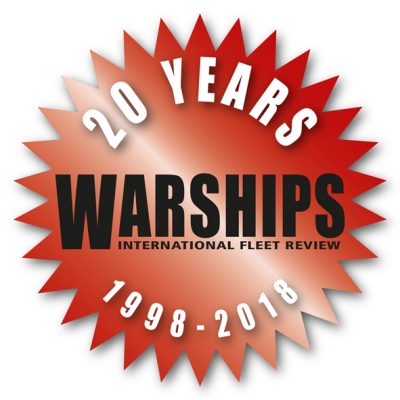 by Founding and current Editor,
by Founding and current Editor,
WARSHIPS International Fleet Review
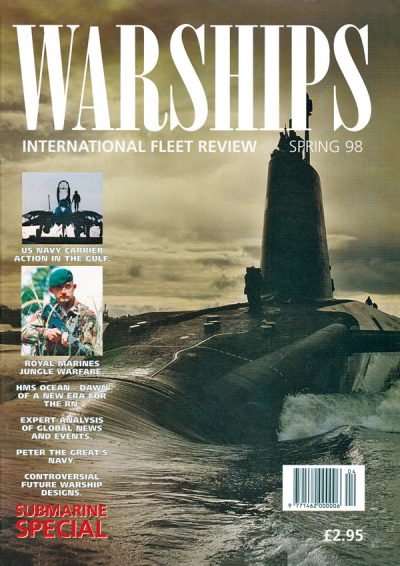
This year sees the 20th anniversary of this magazine’s first edition, published in April 1998, and a survey of that maiden publication’s contents reveals a radically different world to the one we inhabit today.
With a mere seven years having passed since the end of the Cold War the world had never seemed more at peace, with the threat of nuclear annihilation finally lifted and Western liberal values seemingly ascendant across the globe.
The once mighty former Soviet Navy was a rusting hulk, with its foremost striking fleet beached on the shores of the Kola Inlet or tied up in harbour and rarely, if ever, seen at sea. China was still inward looking when it came to defence matters. It possessed an elderly, not very strong or adventurous, though quite large, navy.
The fleets of NATO – the Western military alliance that held the line for 40 years prior to fall of the Berlin Wall in 1989 – were in state of gradual downsizing, to achieve the ‘peace dividend’ their governments felt was owed.
There remained but one zone of hot war where navies were engaged in a major way and that was in the Arabian Gulf. US Navy super-carriers were poised to launch air strikes to persuade Saddam Hussein that he should comply with inspections by United Nations weapons experts seeking to ensure he did not possess Weapons of Mass Destruction (WMD).
Overall the world seemed to have reached a blessed place where global trade flowed along sea lanes free from threat and air travel was cheap, where the old enmities of the Cold War had dissolved. Navies seemed not to be needed much, with their ships of steel and weapons of war out of step with a placid New World Order, achieved by the establishment of Pax Americana via the one remaining hyper-power navy.
The mission statement that I wrote to introduce the first edition pointed out, however, that ‘navies continue to influence geopolitical events, often unseen and unsung.’ It added: ‘This magazine’s aim is to throw light on their activities, to comment on and observe their continuing development.’
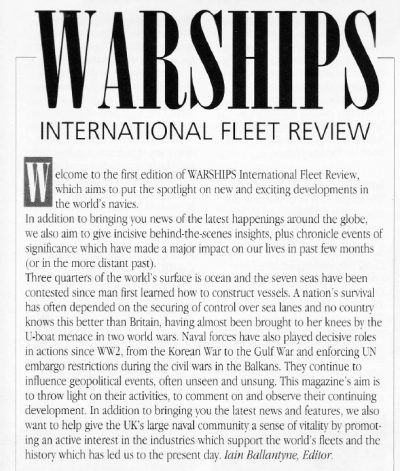
WARSHIPS IFR has remained true to that aim for the past two decades and it wasn’t long back in the late 1990s before the first conflict milestone on the long road to the troubled world of today.
Following on from US-led air strikes and cruise missile bombardments of Iraq – to try and eliminate the alleged residual WMD threat – NATO in the summer of 1999 engaged in a hot war for the first time in its history. Sea-based strike jets, along with cruise missiles fired by surface ships and submarines, were unleashed to try and force Serbia to halt an ethnic cleansing campaign in its rebel province of Kosovo.
There was a tense confrontation at Pristina airport when Alliance forces engaged in a stand-off with Russian troops sent to stop their Slav allies from being totally humiliated by NATO. It was a sign of things to come, especially after Vladimir Putin became President of Russia later the same year.
For now, however, Russia remained a vanquished power as far as the West was concerned, a rusty sword stuck in its scabbard. When the Oscar Class nuclear-powered cruise missile submarine Kursk sank in the Barents Sea in August 2000 – after the vessel’s torpedoes exploded inside a weapons compartment – it seemed so emblematic of a supposedly defeated Russia. In the aftermath Putin vowed to revive Russia’s military and naval might.
That resurgence seemed unlikely to ever happen and world events soon took a surprising turn, heralded by an event in Aden harbour in October 2000. Al-Qaeda terrorists attacked the US Navy destroyer USS Cole while she was on a refuelling stop. Seventeen sailors were killed and 39 injured, with the ship only saved due to a heroic damage control effort.
THE September 11, 2001 Al-Qaeda attacks on New York and Washington D.C. diverted the USA and its allies away from keeping the lid on Saddam, for a long war in Afghanistan.
It soon changed from being a punitive action against Osama bin-Laden and Al-Qaeda into a fight against the Taliban and an attempt at nation-building. Naval strike forces were involved in the opening phase and then committed to supporting the land campaign, with the sea soldiers of the USA and UK also among those committed to the fight in a landlocked country.
Further stoking the flames of global conflict, in 2003 the USA launched an invasion of Iraq, along with its ‘coalition of the willing’. That venture arguably destabilised the entire Middle East and opened the door for Iran to reach for regional hegemony.

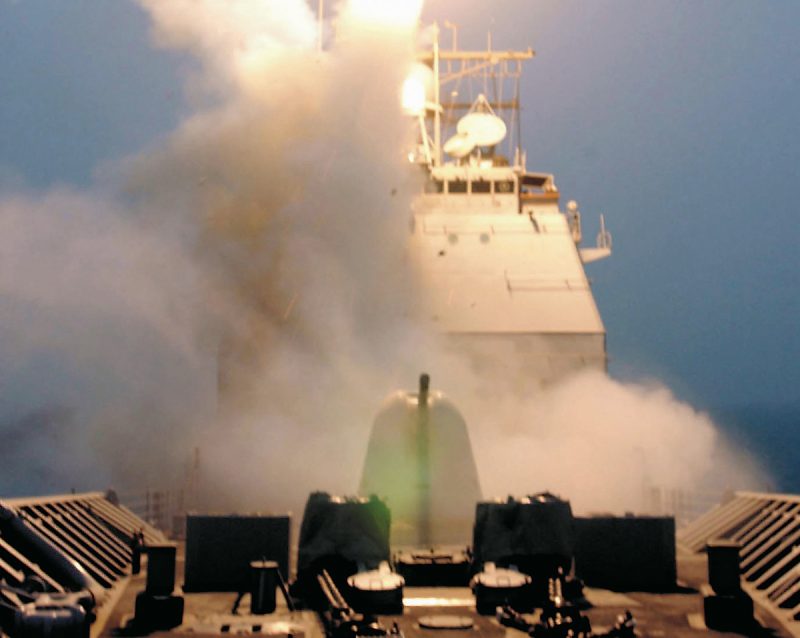
As if combat support roles in those conflicts were not enough for navies to handle, multi-national naval task groups were also formed to combat not only terrorist activity on the ocean wave, but also the growing scourge of piracy off the Horn of Africa. It seemed the global commons of the sea was not so placid after all. A player in the anti-piracy mission was China, which sent new, highly capable warships to join the multi-national effort off Somalia.
With the Iraq involvement declining for the USA and its allies and the Western (including NATO) involvement in Afghanistan winding down, trouble was not long in coming elsewhere. The Arab Spring of 2011 saw destabilisation of regimes spread like wildfire across North Africa and into Syria. With America committing 60 per cent of its naval forces to Asia-Pacific – to meet a growing Chinese naval challenge and rising North Korean nuclear threat – the UK and France ostensibly led NATO’s intervention in Libya. They aimed to prevent its despotic ruler, Muammar Gaddafi, from massacring his own people as they rebelled. French, Italian and American naval strike jets were launched from offshore.
Meanwhile, the David Cameron-led coalition Govt in the UK had continued to follow the peace dividend policy of the 1990s, in late 2010 discarding the nation’s strike carrier power. It would be around a decade before the Royal Navy could once again send fixed-wing jets to sea, while Cameron also got rid of Britain’s Maritime Patrol Aircraft (MPA) too, opening up another decade-long capability gap.
The Royal Navy still played a key role in the Libya campaign via its frigates, submarines, destroyers, mine-hunters and helicopter carrier, though it was the contribution of a single American vessel that was the most dramatic. The guided-missile submarine USS Florida fired 99 cruise missiles into Libya during the opening phase of the campaign, more than the British fleet possessed in its entire inventory.
Having witnessed a key ally eliminated – and Gaddafi executed by a mob – the Russians decided they could not let a similar fate befall Syrian dictator Bashar al-Assad. At stake for Moscow was key access to the ocean – the pursuit of which has been a constant of Russian defence policy since the time of Peter the Great.
To ensure the naval base at Tartus in Syria could not be denied to it – as the Libyan refuelling stops now were – Russia decided it must act. The main play in ensuring access to the Mediterranean came not off Levant, however. To secure the naval bastion of Sevastopol in March 2014 the Russians annexed the Crimean Peninsula.
It was from that launchpad that Moscow would stage much of its Syrian intervention – via constant shipments of troops and supplies. Sevastopol-based cruise-missile firing surface warships joined submarines operating from Tartus and corvettes sailing in the Caspian Sea, to bombard ‘terrorists’ in Syria. Missile boat diplomacy that had for so long been the preserve of the American and British navies in the post-Cold War era was now also a speciality of the Russians. The Americans, meanwhile, used their sea-launched cruise missiles to punish Assad for using chemical weapons on his own people.
As if the turmoil in the eastern Mediterranean, and rising tension in the Black Sea was not enough, China had by 2017 begun to exert a much greater presence at sea while constructing fortresses on reefs and islands in the South China Sea in the maritime equivalent of a land grab for a vast area of ocean. Beijing also deployed task groups of frigates and destroyers into the Med, the Black Sea and Baltic, while operating a new aircraft carrier (the first of several it plans to build).

Strike carriers and big deck amphibious assault vessels remain the arbiters of world affairs and any nation that aspires to be a major naval player has, over the past 20 years, invested heavily in such vessels, namely France, India, Italy, China, Australia, Spain, Japan, South Korea, the UK and the USA. Russia’s ambitions in that regard have been thwarted, but not when it comes to submarines, which are proliferating as never before. Two decades ago it was predicted that nuclear-powered submarines were so expensive they would go the way of the dinosaurs, except today they flourish, as do advanced conventionally-powered submarines.
THOSE are just some of the contours of a complex and rapidly evolving naval scene that is so different to where we were in 1998 when this magazine started. It would be wonderful to report two decades on from the first edition of this magazine that nothing has changed, that navies are struggling to find employment, that the swords have all been turned into ploughshares.
Unfortunately, we are now in an era of naval arms races, conflicts and strongmen seeking to lead their nations to greater wealth and power. In that sense, the wheel of history has turned full circle, returning us to the bad old days of hard power and brute force that existed prior to the end of the Cold War.
The current face-off in the eastern Mediterranean – with Russian naval forces at sea on a war footing while the surface warships and submarines of the USA, UK and France gather to potentially launch strikes against Syria for alleged use of chemical weapons – is the most serious confrontation of its kind since the Cuban Missile Crisis of October 1962.
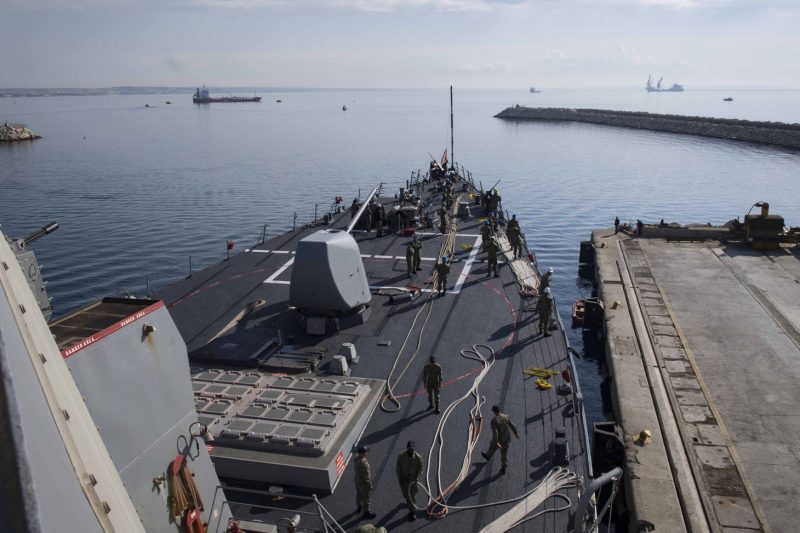
The world appears to be on the edge of an abyss, with the Russians threatening to not only shoot down any incoming missiles but also attack the naval forces of the West that launch them. Above all of that hangs the terrifying spectre of a nuclear exchange, for the Kremlin is all too willing to threaten such apocalyptic action while President Trump seems unable to resist making similarly dramatic threats via social media.
The world holds its breath and prays that we do not see a major sea battle between the West and Russia that rapidly runs out control and threatens to devastate the globe. Those are the kind of words I could never have imagined writing when WARSHIPS IFR was first published two decades ago.


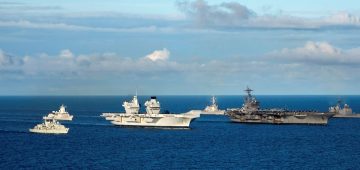




Comments
Sorry, comments are closed for this item